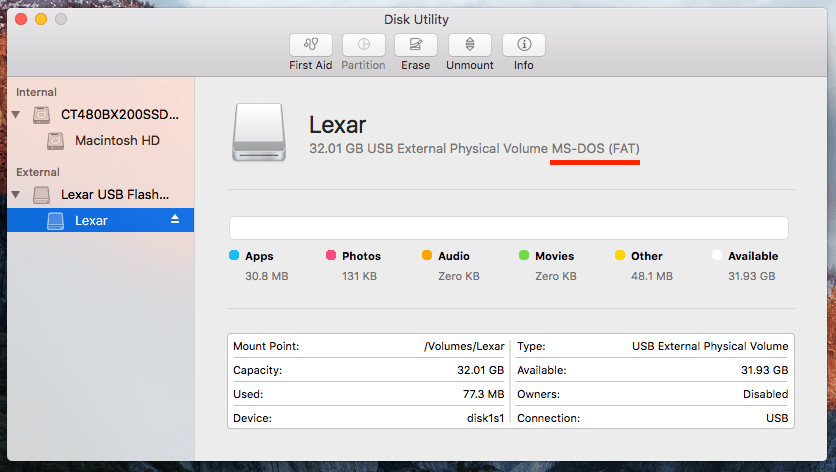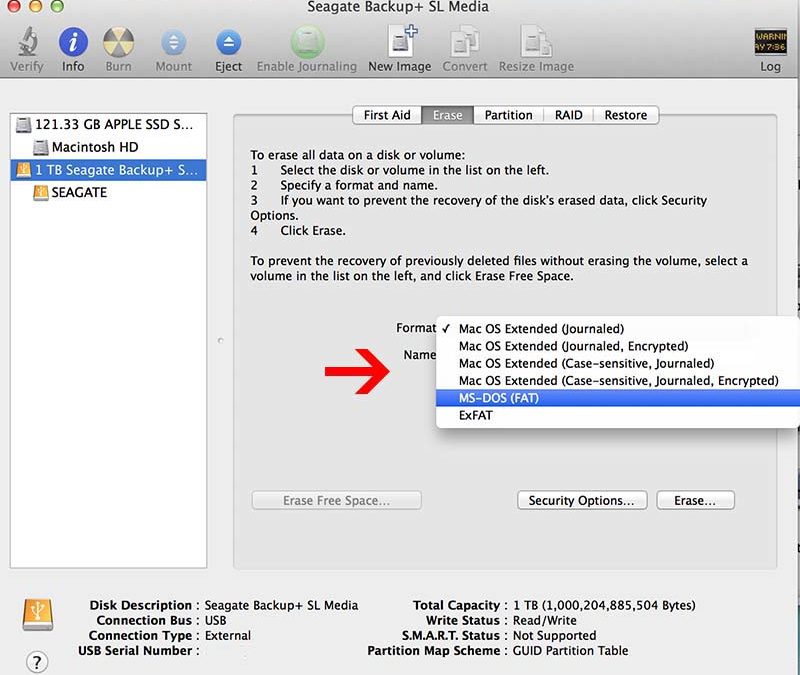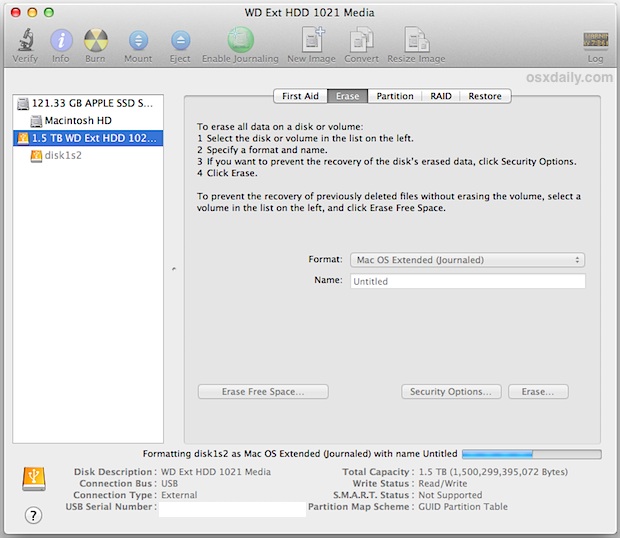Nov 10, 2020 Ejecting your external hard drive tells Mac OS to write that information down to the drive. Then you can safely remove the drive from the computer. You eject your external hard drive from a Windows PC as well. So the PC writes down all necessary data to the drive and then its safe to take out the USB cable. The Mac has long since died and been replaced by several Windows PCs which can't access that HD (I think it's formatted Mac OSX Extended Journaled but i'm not entirely sure). I want to be able to access that HD over the local network from any of several Windows PCs I now have in my home. My hard drive crashed on my Imac took it to computer repair they installed new hard drive, tried to recover data but could not, when we presented the imac to the apple store they told me i would have to buy back my old hd from them um hello no way, so thats why we went to another place that works on macs, so apple said i had lion on the mac, i. Mac OS Extended (Journaled) does not work natively with Windows. If you need to go between macOS and Windows then format your drive ExFAT on macOS IMPORTANT: Reformatting the drive will erase all data on the drive, so you should copy any data you want off the drive prior to formatting. Sep 06, 2019 Have read your article on how to get mac OS onto a blank SSL (in my case in a 2011 Mac mini that won’t boot into Recovery mode.) with an installer USB drive. Unfortunately, you do not address the problem of being unable to download the High Sierra installer from the App Store to a working Mac running under Catalina.

Disk Utility User Guide
Disk Utility on Mac supports several file system formats:
Apple File System (APFS): The file system used by macOS 10.13 or later.
Mac OS Extended: The file system used by macOS 10.12 or earlier.
MS-DOS (FAT) and ExFAT: File systems that are compatible with Windows.
Hard Drive Mac Os Extended Journaled In Windows
Apple File System (APFS)
Apple File System (APFS), the default file system for Mac computers using macOS 10.13 or later, features strong encryption, space sharing, snapshots, fast directory sizing, and improved file system fundamentals. While APFS is optimized for the Flash/SSD storage used in recent Mac computers, it can also be used with older systems with traditional hard disk drives (HDD) and external, direct-attached storage. macOS 10.13 or later supports APFS for both bootable and data volumes.
APFS allocates disk space within a container (partition) on demand. When a single APFS container has multiple volumes, the container’s free space is shared and is automatically allocated to any of the individual volumes as needed. If desired, you can specify reserve and quota sizes for each volume. Each volume uses only part of the overall container, so the available space is the total size of the container, minus the size of all the volumes in the container.
Choose one of the following APFS formats for Mac computers using macOS 10.13 or later.
APFS: Uses the APFS format. Choose this option if you don’t need an encrypted or case-sensitive format.
APFS (Encrypted): Uses the APFS format and encrypts the volume.
APFS (Case-sensitive): Uses the APFS format and is case-sensitive to file and folder names. For example, folders named “Homework” and “HOMEWORK” are two different folders.
APFS (Case-sensitive, Encrypted): Uses the APFS format, is case-sensitive to file and folder names, and encrypts the volume. For example, folders named “Homework” and “HOMEWORK” are two different folders.
You can easily add or delete volumes in APFS containers. Each volume within an APFS container can have its own APFS format—APFS, APFS (Encrypted), APFS (Case-sensitive), or APFS (Case-sensitive, Encrypted).
Mac OS Extended
Choose one of the following Mac OS Extended file system formats for compatibility with Mac computers using macOS 10.12 or earlier.
Mac OS Extended (Journaled): Uses the Mac format (Journaled HFS Plus) to protect the integrity of the hierarchical file system. Choose this option if you don’t need an encrypted or case-sensitive format.
Mac OS Extended (Journaled, Encrypted): Uses the Mac format, requires a password, and encrypts the partition.
Mac OS Extended (Case-sensitive, Journaled): Uses the Mac format and is case-sensitive to folder names. For example, folders named “Homework” and “HOMEWORK” are two different folders.
Mac OS Extended (Case-sensitive, Journaled, Encrypted): Uses the Mac format, is case-sensitive to folder names, requires a password, and encrypts the partition.
Windows-compatible formats
Choose one of the following Windows-compatible file system formats if you are formatting a disk to use with Windows.



MS-DOS (FAT): Use for Windows volumes that are 32 GB or less.
ExFAT: Use for Windows volumes that are over 32 GB.
By default, your Windows PC can’t access the drives that are formatted in the Mac file system. It’s easier for your PC to read NTFS (Windows file system) and FAT32/exFAT, however, the Windows 10 can’t actually read drives formatted in other file systems that are likely coming from Mac (HFS+) or Linux (ext4).
The UFS+ is the file system by Apple’s Macintosh and if you are using a Mac-formatted drive on your PC, chances are it’s not readable by Microsoft Windows 10. The macOS Extended (HFS+) is a file system used by Mac and it can only be read by default in Mac systems, unlike Windows. If you are trying to use a drive formatted in Mac on Windows 10, it’s possible. Here’s how.

Mac Os Journaled Hard Drive Windows Xp
How To Read Mac’s UFS Drive On Windows 10
To read drives formatted in Mac on your Windows 10 PC, here’s what you need to do, just follow these simple steps.
- Get this free tool called HFSExplorer for Windows.
- Install and launch the program, you will need Java to use this software. It will prompt you if your system doesn’t have Java installed, if you already have, it will run normally.
- Connect your Mac-formatted drive on your Windows PC and select ‘Load file system from the device’ from File in the menu bar. Click Load.
- You will see the contents of the HFS+ drive in the app window. Choose the files or folders you want to copy, click Extract to copy and save to a specified folder, the files or folders will be copied to the location you choose on your PC.
Don’t expect any fancy UI or any system integration that allows you to access the drive from the Windows Explorer just like you usually do for other drives. This tool is good if you need to get a few files out of the drive, not recommended if you are looking for a chunk of files to extract out of it, the process might be a tad difficult and time-consuming.
Also, the HFSExplorer doesn’t support write access to the drive, if you want to copy anything in the drive, it’s not possible with this tool. Use it if you want to copy the data from the drive. Check on the alternative if you want the read and write access with better integration.
Better Alternative?
An alternative to it is the Paragon HFS+ software that seamlessly integrates into the Windows such that you will be using the drive as you normally do with other drives supported by Windows. Plugging in the drive, and you will see a device connected and shown in the explorer along with your internal drive.
- Get the software Paragon HFS+ for Windows and install it as you would do for other Windows programs.
- That’s it, restart the PC and connect the drive.
- You will be able to see the drive in the explorer which can be accessed by the keyboard shortcut Windows logo key + E or double click on This PC on desktop.
The only downside is that this software is not free, you will spend about $19.95 for it, however, the good part is it offers a 10-day free trial to give it a try. You can either save the money if you are just copying the data or get the write access with system-wide integration for a mere cost.
In the end, it’s now possible to use the Mac drive on Windows, although not in a straightforward way, you may end up using the apps for file transfers or unlikely buying out softwares. It is recommended to format the drive in the exFAT system to get things easier, this helps if you are using the drive frequently on both the systems.
More Mac stuff can be found here – Mac tutorials, guides, tips, tricks, and hidden features. To get updates on the latest tech news, smartphones, and gadgets, follow us on our social media profiles.
Instagram | Facebook | Twitter | Youtube | TikTok

Comments are closed.